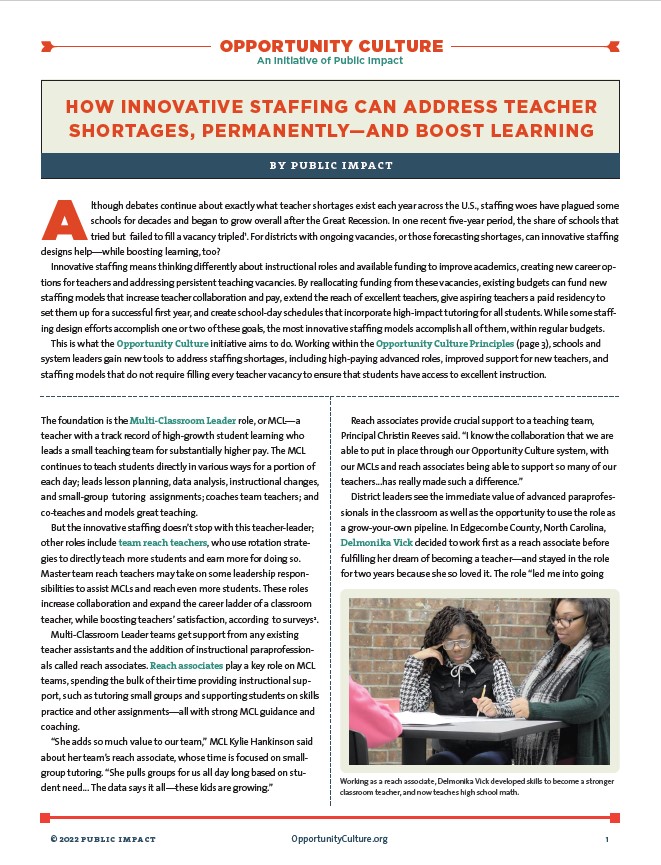Staffing shortages have plagued some schools for decades. How can innovative staffing designs help—and boost learning?
Innovative staffing means thinking differently about instructional roles and available funding to improve academics, creating new career options for teachers and addressing persistent teaching vacancies. By reallocating funding from these vacancies, existing budgets can fund new staffing models that increase teacher collaboration and pay, extend the reach of excellent teachers, give aspiring teachers a paid residency to set them up for a successful first year, and create school-day schedules that incorporate high-impact tutoring for all students. While some staffing design efforts accomplish one or two of these goals, the most innovative staffing models accomplish all of them, within regular budgets.
This brief explains how the Opportunity Culture initiative aims to meet all these goals. Working within a set of five Opportunity Culture Principles, schools and system leaders gain new tools to address staffing shortages, including high-paying advanced roles, improved support for new teachers, and staffing models that do not require filling every teacher vacancy to ensure that students have access to excellent instruction.
Hear from Opportunity Culture educators and district leaders about the roles:
- The Multi-Classroom Leader role, or MCL—a teacher with a track record of high-growth student learning who leads a small teaching team for substantially higher pay. The MCL continues to teach students directly in various ways for a portion of each day; leads lesson planning, data analysis, instructional changes, and small-group tutoring assignments; coaches team teachers; and co-teaches and models great teaching.
- Team reach teachers, who use rotation strategies to directly teach more students and earn more for doing so. Master team reach teachers may take on some leadership responsibilities to assist MCLs and reach even more students..
- Reach associates, who play a key role on MCL teams, spending the bulk of their time providing instructional support, such as tutoring small groups and supporting students on skills practice and other assignments—all with strong MCL guidance and coaching.
- Teacher residents, who get paid for a role that would otherwise be played by a reach associate. Unlike the short stints of standard student teaching, these teacher candidates learn on the job for a full year, with heavy MCL guidance and feedback.
And take a closer look at two Texas districts using Opportunity Culture models, including teacher residencies, to great advantage.
With a paid, yearlong residency and intensive MCL guidance, aspiring teachers can jump in right away to provide small-group tutoring while also having the time to gain the skills needed to lead a whole class. Teacher residents become a key piece to solving the staffing and scheduling puzzle of how to provide high-dosage, in-school tutoring for all students.
These residencies can broaden the teacher pipeline, attracting and retaining more people of color—also benefiting students—and those who otherwise struggle with the costs to become a teacher.
As districts continue to feel the pinch of persistent educator shortages, taking this approach to innovative staffing can not only ease the burden on educators, but lead to dramatic learning improvements, for all students, consistently.

